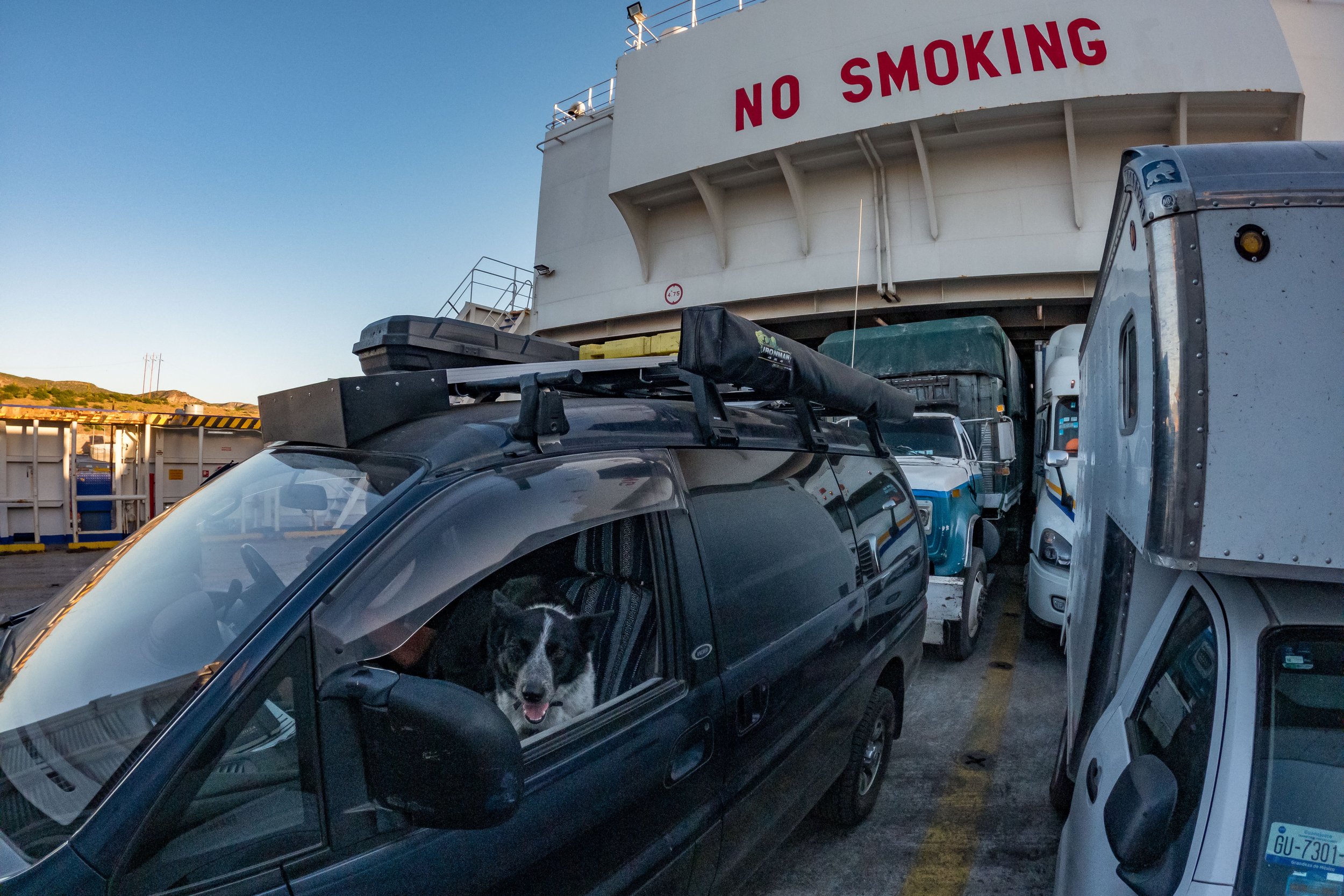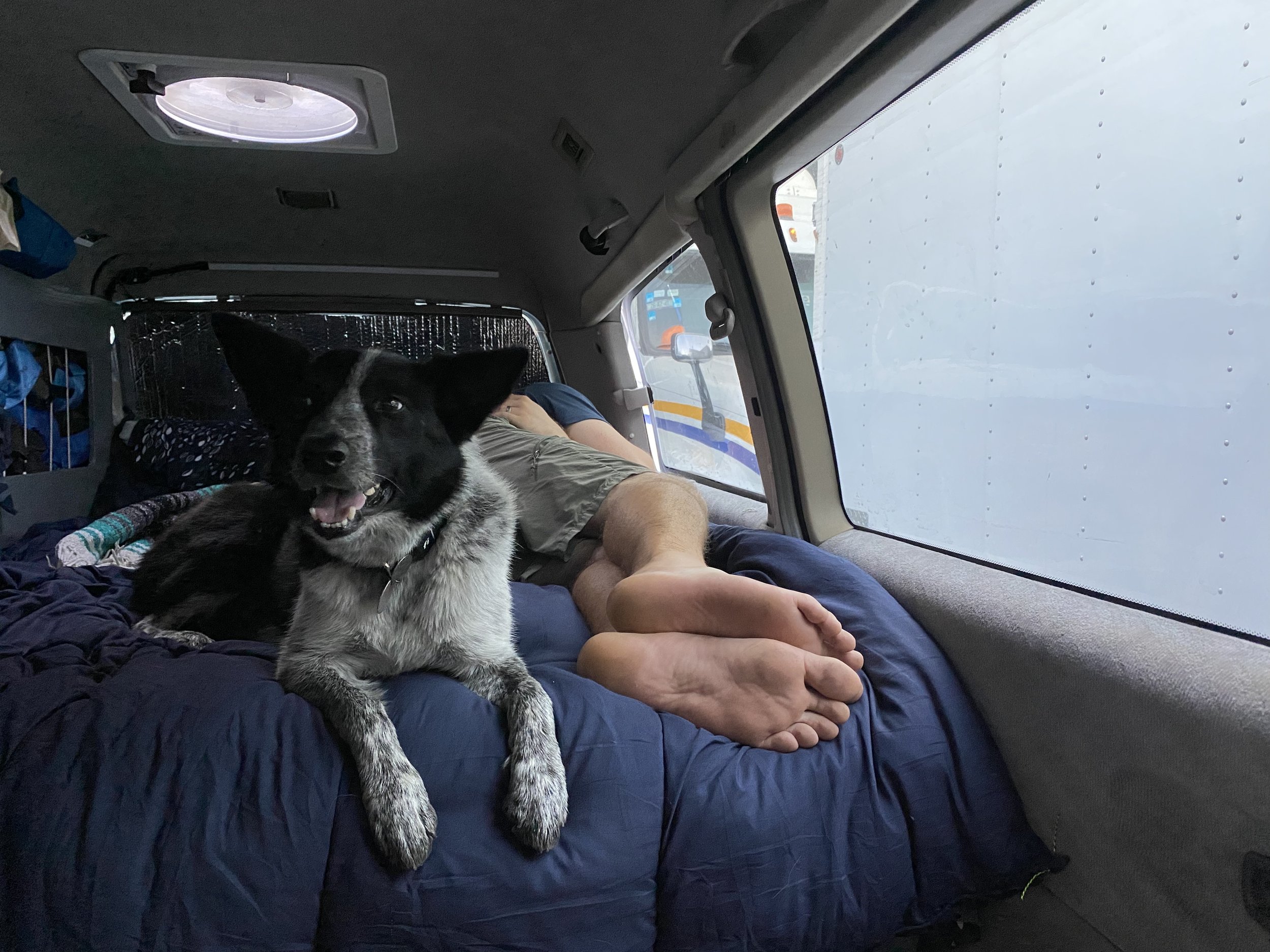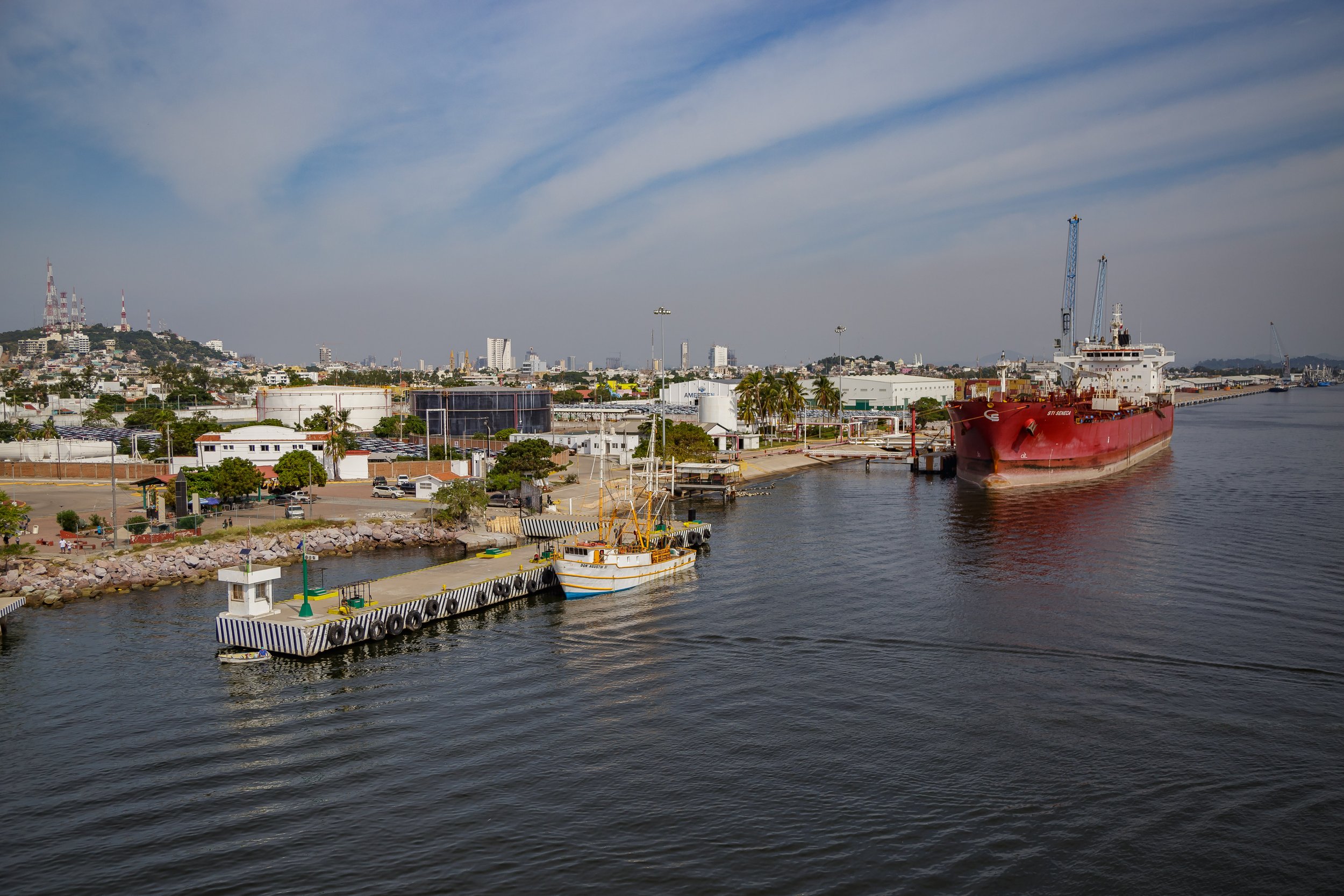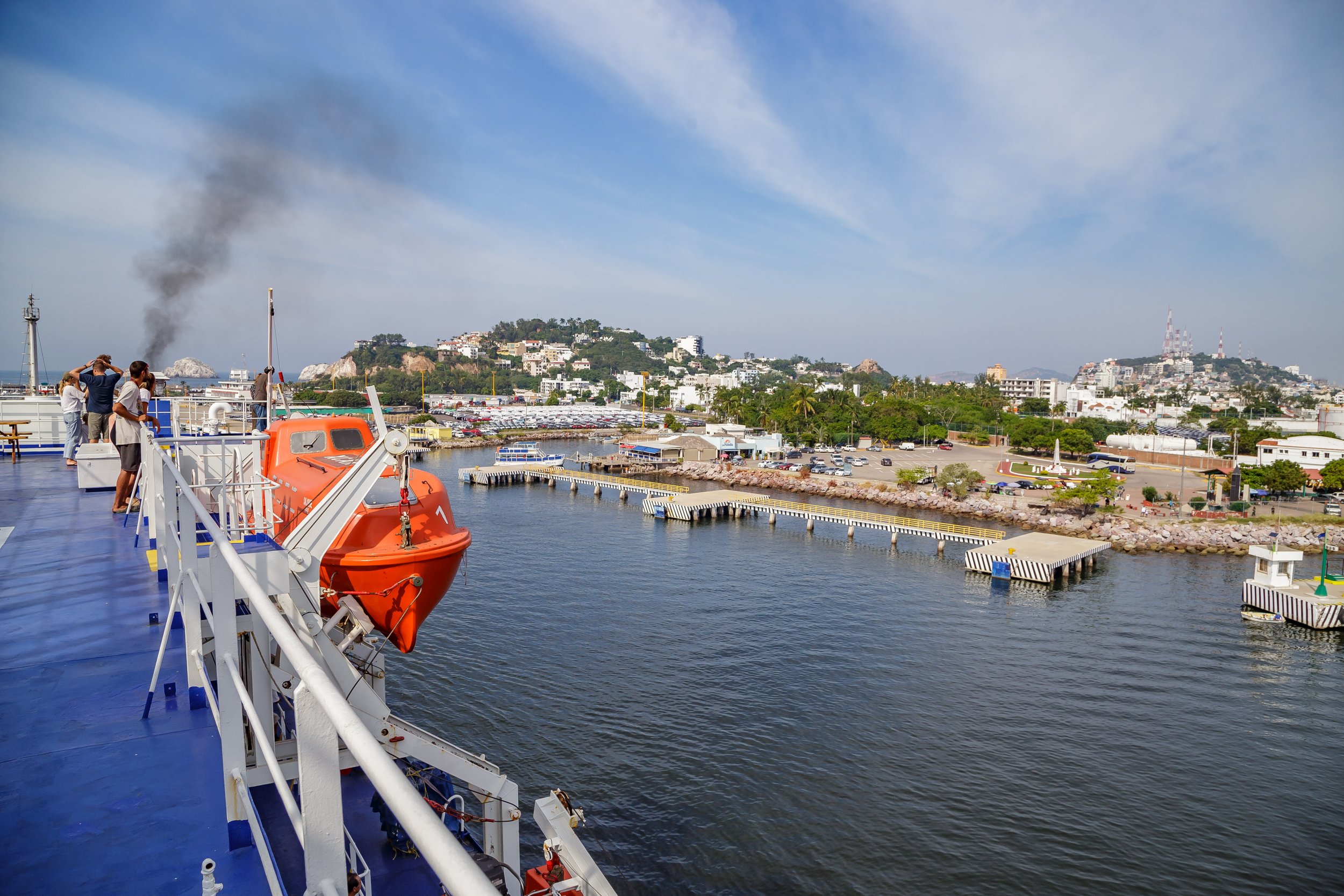Nov 3 - Nov 4 : Ferry to Mainland Mexico
/Taking the ferry across the Sea of Cortez from La Paz, Baja Sur to Mazatlán, Sinaloa had been a focal point for the beginning of our trip. Its necessity had remained constant in the back of my mind; if we chose to drive down Baja and we chose to tour mainland Mexico again, we would have no choice but to take the ferry. I know that the ferry service is an integral piece of infrastructure to Baja, and by no means is it an expeditionary experience for the hundreds or thousands of locals that use it every week, but for us it was a literal rite of passage, a rock left unturned from the last Baja trip and a path ignored from the last Mexico trip.
Part of our apprehension came from the perceived difficulty of setting up a reservation, which ended up being remarkably straight forward, even for two non-Spanish speakers like ourselves, but the rest of our fears laid in the expected discomfort for us and the dog. It’s not a long ride, maybe 15 hours, but Chelsea suffers from motion sickness, and there were no accommodations for the dog, and I had read that we would likely be surrounded by idling semi trucks all night. We had opted to use TMC ferries, the commercial/industrial option for sailing out of La Paz because they were the outfit that would let us sleep in our vehicle and didn’t require Gracie to be kenneled and left in the ship’s cargo hold. The downside, of course, being that we would be sleeping in our van on a commercial/industrial ferry.
On the morning of our departure, we left the RV park early-ish after getting a surprisingly good breakfast at a surprisingly good coffee shop attached to the park. I had been eyeing this little coffee shop, and I had written it off, assuming it was going to just be an amenity level establishment that didn’t have enough business to be really good, but boy was I wrong.
We made a quick Walmart stop to resupply some snacks and waters for the journey, in case we needed some quick bites. We had heard that the ferry offered two meals with the ride, but we weren’t sure what that meant, so we brought backups of chips, fruit and bread. Then we were off to the docks, an unknown place for us, with its own set of unknown systems and expectations and rhythms.
Thankfully, there were a few well written, step-by-step accounts of how to board the ferry written by other overland travelers, perfect for those that haven’t encountered commercial ferry yards before. We got in line right at 11am to enter the port at the direction of a perturbed traffic cop, but after sitting motionless for twenty minutes in a line of semis and watching smaller trucks whizz past us, we exited the line, blew past the same perturbed cop who paid us no attention, and slipped into the actual line to get inspected and weighed (I am not sure what that first cop was asking us to do, he didn’t want us to enter the port from the northbound lane, had us make a U-turn, sit in traffic, and then when we merged into the southbound lane he just ignored us as we entered the dockyard. I rarely understand what is happening with traffic patterns in this country, it seems like the rules are constantly changing).
The inspections went easily, mostly because we were expecting them. The security check pulled us into “secondary” which at the port just meant we moved forward and out of line so the big trucks could get past while a dock worker asked to see inside our kitchen and under our bed and in our roof box to check for weapons (and maybe drugs?). From there we got in line for the scales and the measurements, and eventually we were given a readout of our weight and length to take to the ticket office. The ticket office was the portion of the pre-trip organization that I had been fearing, as I understood it was the place where a reservation becomes reality, and some days you just don’t get on the boat. Luckily for us it went smoothly, due mostly to a generous helping of grace and patience from the ticketing staff, and soon we had tickets and papers and a ship assignment for the San Jorge ship to Mazatlán! All we had to do now was find the boat.
Earlier in a blogpost I described surface border crossings as having a system that is often invisible to the international traveller, partially due to language and cultural barriers, partially due to inexperience, and sometimes due to a shroud of energetic hubbub and perceived chaos. It was much the same at the docks. I knew there was a system - the people that ran the docks were professionals and likely much smarter than me - but to my untrained eye all I could see was chaos. Where I knew there were teammates all moving together to accomplish a shared goal, all I could see were individuals whipping semi trucks around disjointed parking lots devoid of lane markers, directional signage, and warnings. I was told our 465 foot long ship was nearby, but I could not see it, and the only direction I got was a vague hand wave towards the security checkpoint and exit of the dockyard, which didn’t seem right. I reported this to Chelsea, and our plan was to have me set out on foot, to poke my head around the myriad of low buildings and office modulars, to try to either find our ferry or distinguish some pattern of traffic that would make sense. Having grown up a rule follower that had just enough contact with ship yards and regional airports to know that you shouldn’t just drive wherever you want whenever you want, I was hesitant to just start driving around a busy dockyard.
I wandered a little, worked my way through some parking areas, asked for the San Jorge in my broken Spanish, and continued to get hand waves and gestures that led me in the same direction, essentially back the way we had come in, which seemed counter intuitive. I reported back to Chelsea, we loaded up in the van, and found a route that almost lead us out of the secured yard, but at the last moment skirted a security fence and opened up into another staging area, complete with our ship. There was no signage for where to park or what to do, and a fleet of small jockey trucks were furiously unloading the ship and parking semi trailers in different parts of the yard. And when I say furiously, I mean it - some of the drivers were doing little controlled burnouts and donuts to change directions before charging up the ferry’s ramp to grab the next trailer to haul off. The tempo of the place made us want to get out of the way, but instead of parking at distance and being baked by the sun, we snuck right in next to the ramp and into the shade of another truck waiting to load the ferry, in a good spot to watch the action and stay close to the loadmaster directing the work, but unfortunately directly downwind from all the dockyard dust being thrown up by the jockey trucks. Can’t win ‘em all.
Eventually we were joined by some more travelers, first a big German overland truck, then a few smaller rigs, some van dwellers, some surfers. A Land Rover that didn’t stop to say hi, skipped the line, and drove straight into the belly of then ship. We pled our case as best we could to the load master and asked for parking on the upper, open deck of the ship as the weather forecast showed clear skies and a calm sea, and we got an understanding nod. The day dragged on into the afternoon, the novelty of watching the jockey trucks’ work faded, but at least the shadows got longer. The cohort of travelers now numbered in the double digits, and all 10-ish of us were getting antsy to load the boat. The woman at the reservation desk had told us to show up no later than 2PM for loading, and the boat would be underway by 5PM. It was rapidly approaching 5PM, and despite being parked directly next to the loading ramp, we couldn’t shake the thought that we had been forgotten. Finally, and one-by-one, we were called to board the ship, up the steep loading ramp and onto the open deck, then directed to 3-point and snug up next to the big trucks, into spots no bigger than a Delica LWB, no bigger than a Honda Civic, no bigger than a GMC van. The guys directing the loading were experts, there was a plan and a system but we couldn’t see it, and once we were jammed onto the boat without an inch to spare, all we had to do was hurry up and wait.
Doing all of our laundry before our big ferry crossing.
The last sunset of our time in Baja (well, kind of…the sun set on us at the ferry terminal, but we were already on the ship, so it doesn’t count…right?)
Chelsea pondering whether cake should be eaten for breakfast.
Don’t ever let Gracie tell you she doesn’t get fed.
The mixed line of vehicles waiting to enter the port.
Made it through inspection…now on to the ticket office with all of our paperwork in hand.
“Which way do I go?”
Tucked into the biggest slice of shade we could find, as close to our ship as possible.
WHY???? - Gracie
Gracie wasn’t as amused with the truck unloading traffic as we were.
Chels laughing at the jockey trucks doing little donuts in the lot as they sped up and down the ferry ramp to unload the cargo.
The theme of the day was “Blue”.
Walking Gracie in the limited shade from the ship and as far out of the way as possible to avoid the dust and calamity from the hubbub of the traffic.
The cement had started to cool down, so we let Gracie take a breather from the stuffy van beside the ship.
Other travelers arrived and liked our staging spot, so they joined us.
Discussions about routes, time on the road and ultimate destinations filled our time as we waited.
The Germans were the first of the overland group to get waved onto the ship…
The load masters finally waved us towards the ramp just after 5pm. Since we were so small, we got to drive forward and then do a three-point turn to get into our parking spot.
Gracie couldn’t tell if she was relieved to be out of the dirt lot and on the ship. We were all grateful that we were loaded AFTER the sun had dipped enough to create shade on the upper deck where we had been parked.
Many of the spaces between the trucks were too narrow to pass through.
Parked “comfortably” on the deck. Now it’s time to wait some more!
Chelsea and I locked up the dog, opened vents, turned on fans, and tried to make the van as comfortable as possible for Gracie while we did a little exploring of the ship. The sun was just beginning to dip low in the sky, casting the world in its daily dose of gold, and we scampered up the ship’s steep stairways to get the best view of the port and the harbor and the sea. Everything was calm on the upper decks as the remaining trucks and overlanders and small vehicles were packed into the hold and onto the main deck. We were able to breathe a quick sigh of relief once Walter was finally surrounded by steel, removing the chance for a bad parking job to cause some damage. The big trucks were chained into place and the little vehicles had to trust their parking brakes and hope for a calm sea.
We wandered around the ship and found the galley, the bridge, the bathrooms and showers, and even what looked to be a gym. The dining room was small, only three tables and maybe 18 chairs, so meals were rushed to make way for the next set of diners. Dinner was served around 6PM, a hearty plate of rice and beans and stewed meat, and the tables were set with fresh tortillas, plates of limes and jalapeños, and the some salsas. I got into a friendly jalapeño eating contest with a truck driver, breaking some cultural and language barriers by embracing the time honored tradition of measuring masculinity by eating spicy food. Dinner was quick, but delicious, and left us waiting to see what was served for breakfast.
Eventually the propellers spun up and the tug boats got into position, the lines were thrown off and we were bound for the mainland, steaming across the still waters of the harbor, the port fading out of view and the lights of La Paz’s malecón twinkling in the distance, giving no competition to the stars above us. We made friends on the deck with the other international travelers, making conversation about the things we understood and the things we didn’t on this new leg of the trip, and about possible routes after we made landfall in the morning. Eventually we all drifted back to our trucks, surrounded by idling semis and surprisingly stagnant sea air coated in diesel exhaust. The van was comfortable enough, and Gracie had little desire to exit the vehicle. The few times I did drag her out to offer a chance to pee, she skulked around, broken hearted that we had forgotten to pack a football field’s worth of grass for her to play on. You’re so spoiled, Gracie I told her. You made me this way, blame yourself she quipped back.
The night passed a little restlessly, but by no means was it the worst sleep we’ve ever gotten while traveling. (Speak for yourself! - Chelsea) Once the ferry hit the Sea of Cortez proper, the swell of the open water induced a gentle roll to the ship. I was fine, but if the journey had been any longer or the swell any larger I probably would have developed some sea sickness. Chelsea had taken a double dose of Dramamine, but then had trouble falling and staying asleep, and reported feeling uncomfortably drunk as a product of the medication. In the morning the other travelers had mixed reports about their conditions, and I think we were all quite happy that the journey was a short one.
I had gotten up a few times during the night to walk Gracie, as I was preoccupied with the knowledge that she hadn’t urinated in hours. I didn’t want her to make a mess in the van, partially because I didn’t want to deal with it but mostly because I know she’s smart enough to feel guilty and ashamed when she soils something that’s part of her den. We snaked our way between the idling trucks, with their air compressors hissing and burping, a rhythmic mechanical cacophony that surprised and scared Gracie but quickly faded in her mind from a possible threat to an overbearing annoyance. With her lead firmly in my grasp we made our way to the the side of the ship, where a waist high railing had some small drainage cutouts at the level of the deck, allowing Gracie to stick her snoot out into the fresh ocean breeze and confirm that we were outside and not inside. I hoped this would prompt her to urinate if she needed to, but no luck. She looked up at me uncomfortably, and I tacitly agreed - we would not be trading the van for a boat any time soon, the sea is too scary. We are overlanders, and there is an entire world to explore above the waves of the ocean.
This grated deck had nothing but water beneath it…it made me nervous.
Twilight on the ship’s deck.
We got lucky and ended up with the smaller vehicles parked beside us, which created a comfortable amount of space to walk and move around our vehicles during the trip.
A plate of delicious food for dinner, with horchata.
Still waiting for the ship to leave - I guess it’s as good a time as any for a beer?
We finally shoved off, just after 7pm.
Breakfast was served around 7AM, and I was excited to see what meal would follow up the previous nights dinner. We were handed a plate of scrambled eggs, chopped liver, and beans, with the standard basket of hot-n-ready tortillas. It was good, but not as good as the dinner the night before. Alas. After breakfast we made our way to the deck by the ship’s bridge to watch for land, still mesmerized by the size of the Sea of Cortez. I don’t know why I erroneously thought the Sea of Cortez was small, maybe because I have only ever compared it to the body of water on the other side of the Baja peninsula, the Pacific Ocean, so by comparison it seems small. But it isn’t, it’s a big body of water, and as someone that has landlocked himself by choice, I was equal parts impressed and terrified by our journey across the water. Maybe it’s age, maybe it’s the shared experience of COVID, maybe it’s my previous work saving lives on the side of a mountain, but whatever it is, I have a much greater sense of my own mortality on this trip than on previous overland adventures. I know we are one step away from catastrophe, and there is no guarantee for tomorrow, or even for today. I said a prayer, asking that the captain of the San Jorge would keep both his hands on the steering wheel, and watch out for traffic, just like Chelsea asks me to do on the windy roads of Mexico (and Idaho).
Eventually land came into view, and soon we could make out the skyline of Mazatlán. Our phones lit up as cell reception returned, allowing us to inspect the port city via Google Maps, and wrap our heads around what we were seeing. The sun rose in the mostly blue sky and the sweet temperatures of the early morning gave way to the heat of the day proper as we got closer to shore, and then just like that we were more terrestrial than oceanic, penned in by the breakwaters and jetties of the harbor, welcoming us back to land.
It seemed like all the travelers waited until the last moment to scurry off the upper decks and down to our vehicles. The drivers were moving with a sense of urgency, checking fluids and cleaning windshields, so we did the same. Soon the first line of vehicles was off the top deck, in a last-on-first-off order, allowing the smallest trucks and vans to exit first and make way for the cargo trucks, then it was our turn to charge down the steep loading ramp and into the great unknown.
Morning. It was a hot and muggy night, and the rocking of the ship may have helped lull me to sleep, but it did the opposite for Chels.
Breakfast - eggs, chopped liver, beans, hot tortillas and a cup of instant coffee. Surprisingly, it hit the spot.
The top-down view from the deck made for some great photos.
Land ahoy!
“Did we really just take a ship across the Sea of Cortez?”
Almost there!
Tug boats at the ready.
Being pushed into place.
One last glamour shot of Walter on the deck with the tug boat working.
WE MADE IT!!!!










































